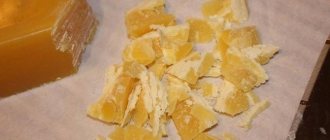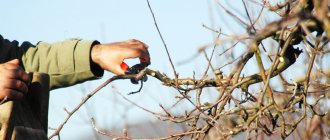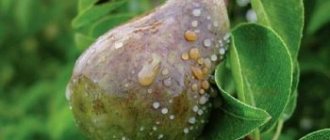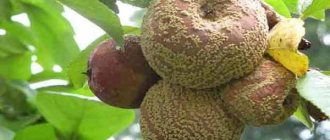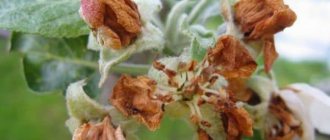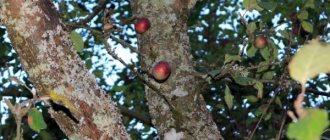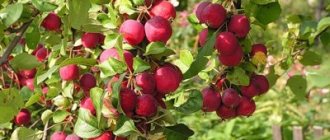The appearance of a hollow in an apple tree is an alarming signal . It is necessary to protect the tree from death and extend its life, to prevent a decrease in yield and growth activity. It is very important to know how to treat a hollow in an apple tree.
The danger increases if the trunk is damaged near the base of the skeletal branches. The strength of wood decreases, and the risk of crown breakage increases.
ATTENTION! Debris accumulates inside the cavity, mosses, lichens, tinder fungi and pests settle. If it is not possible to immediately remove small depressions in the barrel, they must constantly be cleaned and whitened.
If the tree is severely damaged and incompatible with life, it is saved by grafting to the wild.
The formation of a hollow in a garden tree is a sign of improper care. The problem occurs as a result of:
- Accidental mechanical damage that was not treated properly (garden pitch).
- Injuries after improper pruning, when a branch is removed, leaving a stump, but it needs to be “on the ring.”
- Frost damage (cracking of wood as a result of freezing water).
- Bark scuffing when branches are cut incorrectly, if the gardener forgets to first cut the base from below.
Timely treatment of wounds is the main prevention of the appearance of hollows, otherwise the colonization of bacteria and fungi will lead to rotting of the wood and increased damage. The cavity, if no action is taken, will increase every year. A serious question arises: “what to do if there is a hollow in the apple tree?”
At what time should I fill up the hollow?
Apple tree hollows are sealed in mid-autumn , less often in winter. In emergency cases, a procedure to improve the condition of the specimen is carried out at any time.
In the spring, cavity filling is carried out extremely rarely due to the intense movement of juices, which causes the destruction of the fixing compounds.
Sanitary treatment of damage (cleaning of debris, whitewashing) can be carried out at any time, but at the time of active metabolic processes of the tree, fungicidal and insecticidal preparations are applied in a minimal dose.
The optimal time for work is a cool and dry autumn, when the apple tree’s metabolic processes decrease. When work is carried out in October, the filling in a small hollow has time to harden.
Work in winter is associated with a number of difficulties:
- At negative temperatures, garden varnish hardens from the cold.
- It is difficult to fill a large cavity in cold weather due to the uncomfortable weather for a person, so minor damage and depressions are corrected at this time.
TIP: Filling large holes with cement is carried out in mid-summer so that the composition has time to completely harden.
A newly appeared hollow is sealed regardless of the time of year , so as not to leave the cavity open for the winter. For example, if in the spring you find a crack with leaking liquid on an apple tree or a bump under an intact bark.
Prevention
You should know that coping with the disease is much more difficult than taking preventive measures.
If there is a need to trim excess branches, then do this in late winter before the sap flows. The cut areas should be treated with varnish, zinc paint, and 1% copper sulfate. But, if a visual inspection reveals obvious signs of rotting, all damaged parts should be removed with a special scraper, removing colonies of the fungus. Next, the wound should be dried, and only then treated with 3% copper sulfate (copper sulfate) or 5% iron sulfate (ferrous sulfate).
After harvesting, the trees are cleaned of old dead bark using wooden knives and scrapers. Many pests live under old scales, and with such preventive measures a gardener can save his apple orchard from a number of diseases. The fallen bark needs to be burned.
Prevention of hollows
To protect trees from frost and sun in winter, they are treated with quicklime. Prepare the mixture as follows: pour two buckets of water into a large container and add, while stirring, a bucket of quicklime in small portions. The mixture is filtered and the entire tree is sprayed using a large-mesh sprayer. This can be done even in winter, during warming periods, but usually such measures are carried out a little earlier.
How to seal a hollow in an apple tree: stages and preliminary cleaning
The choice of filling the hollow depends on its size.
Stages of work:
- Cleaning the hollow from debris and dead wood.
- Treatment with fungicides and insecticides.
- Sealing the cavity (the filling compound should not extend beyond the edges of the cavity).
Cleaning the walls of the hollow from rotten wood is carried out with a chisel, garden knife, chisel, scoop and other suitable tool. Cleaning is carried out until healthy wood is removed, which is slightly removed.
The cavity is wiped, all small debris is brushed away, then allowed to dry. There should be no moisture on the walls before treatment with disinfectants.
With a large cavity volume in a thick tree trunk, complete cleaning is difficult. An artificially small passage is made to make it easier to view the internal walls for processing.
If the hollow shape is difficult to reach, a flashlight and a bent teaspoon or tablespoon will help. It is necessary to scrape away rotten black wood to light layers.
A hollow that was discovered after cutting a branch.
ADVICE . All garbage is collected in a plastic bag and burned, as rotten residues should not be allowed to get into the soil to prevent contamination of the garden. The edges of the hollow are cut to a light shade to stimulate regeneration processes.
Sometimes the process of scraping out rot by hand is too labor-intensive, so with a special attachment with metal brushes is used Safety glasses will protect your eyes from debris and infections during cleaning.
The hollow is rotting from the inside
If there is a void in the trunk, but there is no obvious hollow, then the tree is in danger of rotting from the inside . An artificial passage is cut or drilled to allow free cleaning. All that remains is to choose what to cover the hollow in the apple tree with.
The hollow is infected with a fungus
Sorrel leaves are suitable for aseptic processing . In case of severe fungal infection and wood rotting, commercial synthetic fungicides are used, as well as Bordeaux mixture and sulfur preparations.
In the case of a large hollow, disinfection is carried out in several stages (3-5 times) every 2-3 weeks. After treatment, the cavity is dried (several hours).
CAREFULLY . During operation, solutions are applied by spraying to reach the furthest zones, so protective equipment (mask, goggles, rubber gloves) is required. The cut edges of the cavity are also processed.
Additional compounds
To further disinfect tissues and prevent their further destruction, surfaces are treated with:
- Pine resin (resin);
- Garden var;
- Special putties with physiologically active substances (purchased analogues of garden pitch or pastes);
- Folk compositions, for example, a mixture of fresh mullein and clay in equal proportions .
Depending on the size of the depression, the compositions are applied only to the walls or cover the damage completely, forming an even layer at the level of the surface of the trunk. After the composition has dried, the problem area is wrapped in a bandage, burlap or other natural fabric, having previously smeared the edges with garden varnish.
The top of the trunk is tied with a layer of film to prevent the material from getting wet.
Filling small holes
After filling, moisture and air stop penetrating into the hollow, which eliminates the processes of decay. Small holes can be plugged with a dry, durable hardwood plug after cleaning and disinfection.
The upper end of the cork is shortened to the level of the edges, the surface must be covered with garden varnish or oil paint based on natural drying oil. Work is carried out using rubber gloves.
Watch the video on how to treat a hollow in a tree. Important details:
A thick mixture of cement and sand (1: 3 or 1: 4) is used to seal up hollows in the apple tree and small holes, after inserting braided wire into them, secured with nails.
Don't want to spoil the appearance of the tree? You can choose oil paint for exterior putty to match the color of the bark.
TIP: One of the simplest methods of filling a hollow is to seal the hollow in the apple tree with foam. It must be remembered that the foam substance increases in volume 3 times within a few hours. Excess can be easily removed by hand. With this method of embedding, the apple tree receives additional insulation, in contrast to the use of cement mortar.
The use of clay and manure as putty is extremely dangerous due to the hygroscopicity of the components. A good result is achieved after completely drying these substances and sealing them from water penetration, for example, using cement putty. In the presence of moisture, rotting cannot be eliminated.
Recommendations from experienced gardeners
Treatment of hollows in fruit trees is often complicated by infestation of the wood with ants. Insects build anthills in loose, diseased wood, further destroying the tree. Insects are removed using scrapers and brushes. The hollow is washed with hot water and soap or a soda solution, and the root zone is irrigated with poisonous preparations.
Attention! When cleaning a hollow, all rot and debris should be cleaned out into a bag or bucket, then burned. You cannot throw away garbage in the garden or compost it, because it contains infection.
Often a hollow is formed near the surface of the earth. You can remove the hole using stones and cement mortar. But treatment makes sense only if the hollow occupies no more than half of the internal volume of the trunk.
It is already useless to treat such a hollow
Basal hollow (in the lower part of the trunk) and through hollow
In the case of root and through hollows, a cement mixture is also used. With a flimsy trunk, the tree becomes dangerous for others, so it is cut down, but the stump is left in the hope that young shoots will appear and a new tree will form.
IMPORTANT. If the diameter of the hole in the trunk is more than 25 cm, install an iron mesh with a cell width of 70-80 mm and a wire thickness of 2-3 mm. You can use wire fixed transversely or obliquely in the hollow using small nails or staples.
Root hollow.
Filling the volumetric recess is carried out using brick chips or small stones, followed by filling with a liquid cement-sand mixture (1: 4). The hole is covered with a board to prevent the composition from pouring out. After the mixture has hardened, a thick cement paste is applied on top.
An external coating with paint or a thick cementitious mortar prevents the formation of a gap between the filling and the edges of the hole.
Various problems with hollows and ways to solve them
There is a lot of rotten wood deep in the trunk
If the tree can be saved , then after cleaning, drying and disinfecting, the hole is filled in the classical way using cement.
Another option: fill the cavity with a mixture of ash and charcoal, and cover the top with a wooden stopper and rubber to protect it from moisture.
Presence of ants
Rotten wood is cleaned out along with ants , all affected areas and ants are poured into a bucket and poured with boiling water. The cavity is treated with an insecticide, the drug is applied to the depth of the tree trunk circle using the digging method.
ADVICE. Compositions containing Diazinon, for example Anteater, have a strong effect. You need to buy the liquid and granular type to seal cracks and spread throughout the area. Additionally, the affected areas are sprayed with fungicidal compounds (Aktellik and Oksikhom).
Ants live in some hollows.
Hollow in an old apple tree
If a tree dies , but is a varietal tree, then it can be saved by grafting it wild. If fruiting is good, you should try to revive the specimen using the above methods.
Causes
A hollow can form due to the fault of the gardener himself. If the bark is pulled up during pruning, bacteria or fungi enter the untreated stump. The trunk cracks under the weight of the apples.
The depression is formed:
- under the influence of wood diseases;
- in case of rodent invasion;
- as a result of freezing of the cut area.
The tree breaks during a storm or hurricane, after which a hole is formed in it. Most often, the problem arises due to neglect of pruning rules and improper care of the plant.
Video: how to seal a hollow in an apple tree
In this video, the gardener shows how to seal a huge hollow in an apple tree with polyurethane foam:
Watch the video on what to do with a hollow in an apple tree. Step-by-step algorithm.
There is a bird's nest in the hollow
You need to wait until the chicks hatch and fly away , and then fill the hollow.
ADVICE. If you want to keep the bird's house, then you should clean and dry the cavity, treat the surface with garden varnish, and attach a rain canopy on top.
After the hollow has dried, the nest is placed in place.
Juice flows from the hollow
Treatment depends on the cause.
When infested with bark beetle or sapwood, injections of Actellik (2 ml/l of water per 1 sq. m of trunk) are given into the pests' tunnels. The next season, after flowering, the apple tree is sprayed with Fufanon (10 ml per bucket of water).
Rotting of wood after improper treatment of wounds leads to leakage. The areas are cleaned with a garden knife, disinfected and after 20-30 minutes covered with a mixture of Rannet paste and garden varnish.
Stripping when treating an apple tree.
Preventive measures
Preventive measures are best used to prevent voids from appearing in the wood.
Spraying an apple tree with copper sulfate.
Copper sulfate
Spraying with a solution of copper sulfate is a good prophylactic against various diseases and lesions. In the trunk of a healthy apple tree, a hollow most often does not occur.
The working solution for spraying is prepared at the rate of 100 grams of dry copper sulfate powder, 100 grams of quicklime per 10 liters of water. This mixture should be enough for 2-3 apple trees.
Garden var
As a measure to prevent the appearance of hollows on an apple tree, garden varnish is used to seal small wounds and cracks. It is also better to regularly inspect the trunk of the apple tree in order to promptly detect any wounds and cover them up.
Places of large cuts or saw cuts are also always well disinfected and coated with varnish. This will prevent infection from entering the apple tree tissue.
